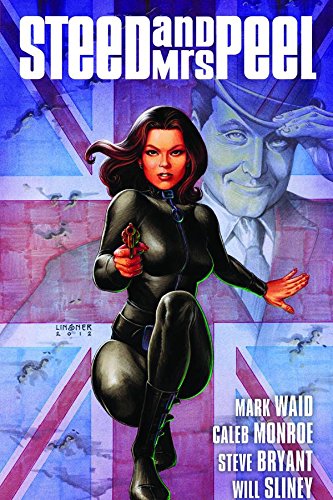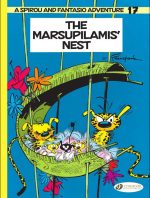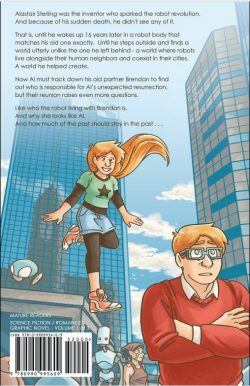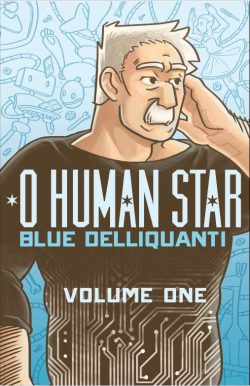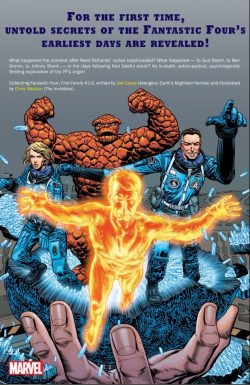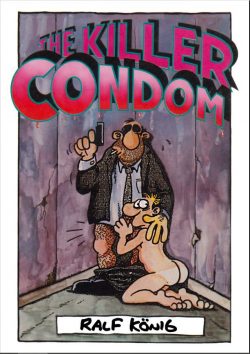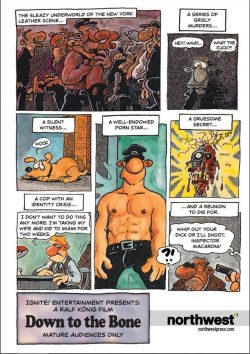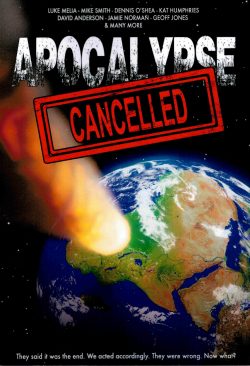

By Jaimie Smart, with Sammy Borras (David Fickling Books)
ISBN: 978-1-78845-230-4 (TPB)
Bunny vs. Monkey has been a fixture of British comics phenomena The Phoenix since the very first issue in 2012: recounting a madcap vendetta gripping animal arch-enemies set amidst an idyllic arcadia masquerading as more-or-less mundane English woodlands.
Concocted with gleefully gentle mania by cartoonist, comics artist and novelist Jamie Smart (Fish Head Steve!; Looshkin; Flember), his trend-setting, mind-bending yarns have recently been retooled as graphic albums available in remastered, double-length digest editions such as this one. In case you’re wondering, the fabulous fun found here originally inhabited volumes 5 & 6, then entitled Destructo and Apocalypse…
All the tail-biting tension and animal argy-bargey began after an obnoxious little beast popped up in the wake of a disastrous British space shot. Having crash-landed in Crinkle Woods – scant miles from his launch site – lab animal Monkey believed himself the rightful owner of a strange new world, despite sustained efforts of reasonable, sensible, genteel, contemplative Bunny to dissuade him. For all his patience, propriety and good breeding, the laid-back lepine just could not contain the incorrigible idiot ape, who was – and is – a rude, noise-loving, chaos-creating troublemaker…
The original collected volumes dispensed disaster-drenched doses of daftness in six-month courses of ill-treatment, but this new compilation covers Year Three from Winter to Winter as first enjoyed in Destructo and Other Ridiculous Stories! and Apocalypse and Other Surprising Stories!.
Here – with artistic assistance from Sammy Borras – the war of nerves and mega-weapons resumes and intensifies. The unruly assortment of odd critters littering and loitering around the bucolic paradise,p finally pick a side: shifting and twisting into bipartisan factionalism. They all seem to have forgotten that rapidly encroaching Hyoomanz are now well underway in building something called a “motorway†right through the sylvan glades and (apparently) unprotected parks…
It all resumes with tiny terror Monkey manifesting more mayhem and almost turning his own stomach inside out whilst attempting to weaponise some very nasty stuff he finds under his feet in ‘Gross!’
With snow on the ground Monkey finds a way to spoil the Great Sled-Off in ‘Tobog-Gone!’ and latterly sets back mammal-robot relations by picking on newcomer ‘Metal Steve 2!’, before a new menace manifests to worry the woodland folk in the dark guise of evil arch-villain ‘Destructo!’
When the weather clears up, Monkey’s Double-Barrelled Supercharged Snow-Cannon-Tank is suddenly deprived of ammo… until the pest repurposes his toy to fire chutney. Sadly, even this resultant chaos is insufficient to his comprehending ‘The Message!’…
A brief and sudden return of evil genius ‘Skunky!’ only leads to disappointment, but his crazed influence remains to monsterize the ‘Pretty Flowers!’, whilst the debut of cyborg bounty hunter ‘Alan!’ (Armoured Locating Armadillo Network) threatens to destabilise the ongoing conflict until the big bully gets on the wrong side of gentle, peace-loving Pig‘s ice cream…
Too much of the good life eventually slows down our friends so they convince eco-warrior Le Fox to help them ‘Get Fit!’just in time for the awful ape to celebrate (or desecrate) Easter by eating all ‘The Wrong Eggs!’
As Spring unfolds, the wee woodlanders face Skunky’s robotic Vulturaptors in ‘Terror from the Skies’, but when night falls, huge ‘Bobbles!’ from the sky spark fears of alien invasion…
The good guys then try to infiltrate ‘The Temple!’ (Skunky’s new high-tech citadel of evil), just in time for ‘The Audition!’ to join the musky mastermind’s new gang the League of Doom. Sadly, the only one making the grade is meek misfit Pig in his new gruesome guise of ‘Pigulus!’…
History horrifically repeats itself when another crashed space capsule ejects an even more destructive newcomer in ‘The Evil Monkey!’ – which only incites the previous incumbent to up his aggravating game…
When the genteel inhabitants of the wood start enjoying ‘Picnics!’, they have no conception the day will end in chaos after Skunky’s escaped Grasshopalong induces the mechanic maverick to attempt recapture with his giant Tarsier…
Occasional ally Le Fox cultivates an air of mystery, but when the League of Doom unleashes a deadly custard assault his annoying old ‘Uncle Fox!’ soon proves to be the real superspy deal, just as Monkey’s latest property deal lands Bunny with an obnoxious ‘Bad Neighbour!’ in the form of musician Bert Warthog.
…But not for long…
When Skunky unleashes his devastating colossal De-Forester 9000, the unthinkable occurs as Bunny and Monkey declare ‘The Truce!’, leading to the mega-machine’s demise, but by the time brain-battered, bewildered former stuntman Action Beaver becomes ‘The Messenger!’ for the skunk’s poison letters, all bets are off again and it’s every critter for himself…
More mad science sees the launch of a weather station and an unseasonal snow barrage, but Skunky’s malignant fun is ruined after Weenie Squirrel demonstrates astounding piste pizazz in ‘Ski-Daddle!’, before a lost little skunk destabilises the wicked stinker. Thomas is unmoved by monster robots like the rampaging Octobosh and truly gets to the emotional soft side of his newfound ‘Uncle Skunky!’…
Perhaps that episode is what prompts his invention of ‘The Truthometer!’, but when Skunky hears what the woodlanders actually think about him, he regrets ever thinking of it…
His Quantum Bibble Fobbulator also goes wrong, tearing ‘Wormholes!’ in the forest fabric, but the rustic residents make the best of the situation, whilst the skunk’s size-changing ray only makes his victims too tall to tackle in ‘The Embiggening!’
The rural riot the escalates with a frankly disturbing insight into the simian star’s softer side as he administers first aid to ailing Bunny and subsequently descends into megalomania as the truly terrifying ‘Nurse Monkey!’…
Easing effortlessly into the middle of the year, ‘The Importance of Being Monkey’ layers on the intrigue as the human scientists who originally rocketed the simian sod – and his evil successor – into paradise come looking for their property – accidentally revealing a deeper plot and properly mad doctor in charge. At least, Monkey has finally been allowed to join the League of Doom…
The deployment of ‘Poop!’ bins outrages and baffles the woods-folk, leading to a disastrous attempt to excise the humans’ daft innovations, after which human child Elouise reclaims her old toy Metal Steve, unaware that Skunky’s “improvements†will soon lead to them all needing ‘A New Home’…
Careless and catastrophic piloting of cetacean construct ‘Wahey-Ell’ reveals Monkey’s astigmatism whilst a new sinister faction targets Bunny in ‘The Order of the Woods’ but events take a deeply disturbing turn when Skunky’s new submersible uncovers a fantastic sunken kingdom ‘Beneath the Waves’ and affable nutter ‘Super Action Beaver’ gets a handy superhero makeover, but nothing prepares the woodlanders for Monkey’s weaponisation of concrete in ‘Stone Cold’…
A beloved hero embraces his evil side in ‘The Crimson Gobbler!’ while Skunky initiates Monkey into the secrets of ‘The Destroy-o-torium’, but wickedness is not restricted to the League as Terence the evil Anti-Bunny cruelly meddles with his good twin’s downtime in ‘Bunny TV’. Having said that, there’s no substitute for the real thing as seen when ‘Monkey with a Flame Thrower’ depicts what happens when the meddler gats access to Skunky’s Cannon Barrel…
The truth behind the chaos and super-science mayhem is revealed in ‘An Important Message’, but as Le Fox leaves it with Weenie and Pig, it’s as good as lost before he’s finished speaking, leaving Skunky and Robot Steve to slice, dice and splice animal DNA and make mockery of nature in ‘Mixey-matosis’…
As Autumn falls, Action Beaver’s inner monologue is explored in ‘Noises’ before Bunny learns never ever to go ‘Camping’ with Pig and Squirrel even as Skunky’s brilliance in stealing all Earth’s colours with ‘The Mono-Chromatron!’ founders on the rocks of sheer idiocy…
The grand design of sinister humans running MeanieCorp Laboratories, the origins of ultimate destroyer the Moshoggothand the truth about Monkey are then systematically exposed in a time-bending extended epic beginning with ‘The Last Broadcast’. The daft drama is expanded upon in ‘To Destinyyy’ and ‘Find the Monkey’ before a valiant defender risks everything to save the Woods, the world and all reality, beginning with ‘Sabotage’; navigating the alternate timeline terrors of ‘Monkey in Charge’ and closing in Winter as the sinister schemes and cosmic carnage affect the memories of those who barely survived in ‘Onwards to Skunky’…
It’s not all safe and fine yet, however, and a final sacrifice is called for as ‘The Monstrous Below’ liberates the Moshoggoth and activates a Reality Discombobulator. Thankfully,
‘Fantastic Le Fox’ is on hand and ensures there’s enough of creation left to carry on by ‘Remembering Friends’…
Adding lustre and fun, this superb treat includes detailed instructions on How to Draw Action Beaver’ and ‘How to Draw Le Fox’, so, as well as beguiling your young ‘uns with stories, you can use this book to teach them a trade…
The absolute acme of absurdist adventure, Bunny vs Monkey is weird wit, brilliant invention, potent sentiment and superb cartooning all in one eccentric package: providing irresistible joy for grown-ups of every vintage, even those who claim they only get it for their kids. This is the kind of comic parents beg kids to read to them. Is that you yet?
Text and illustrations © Jamie Smart 2021. All rights reserved.

